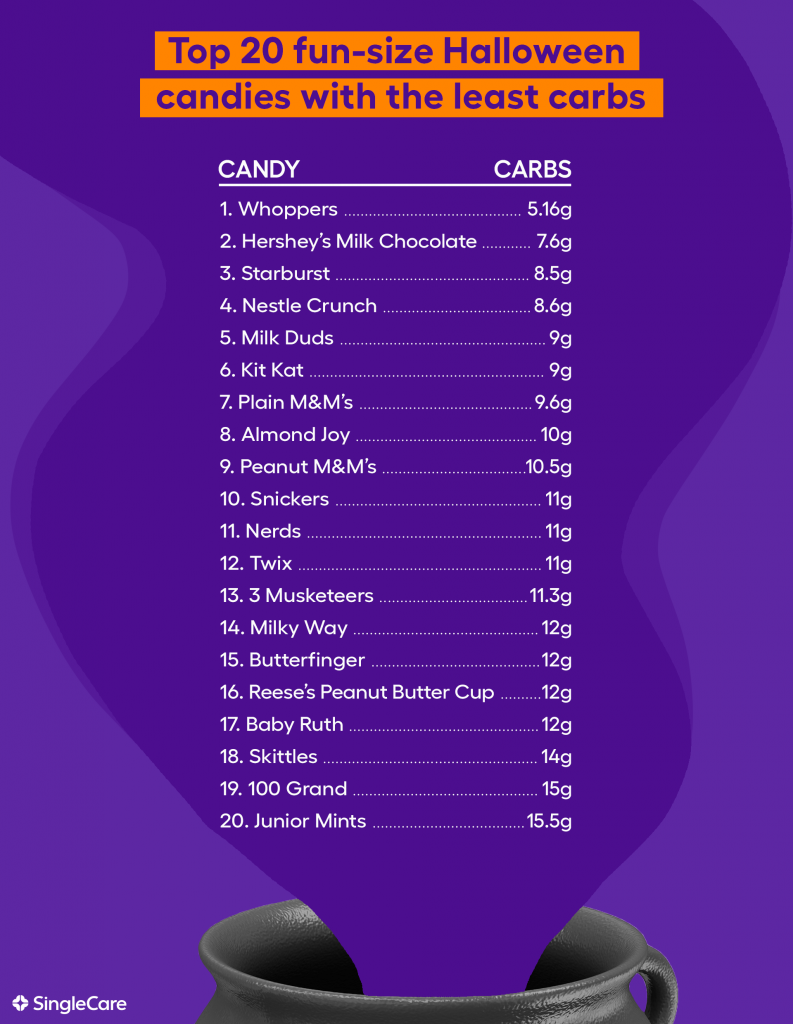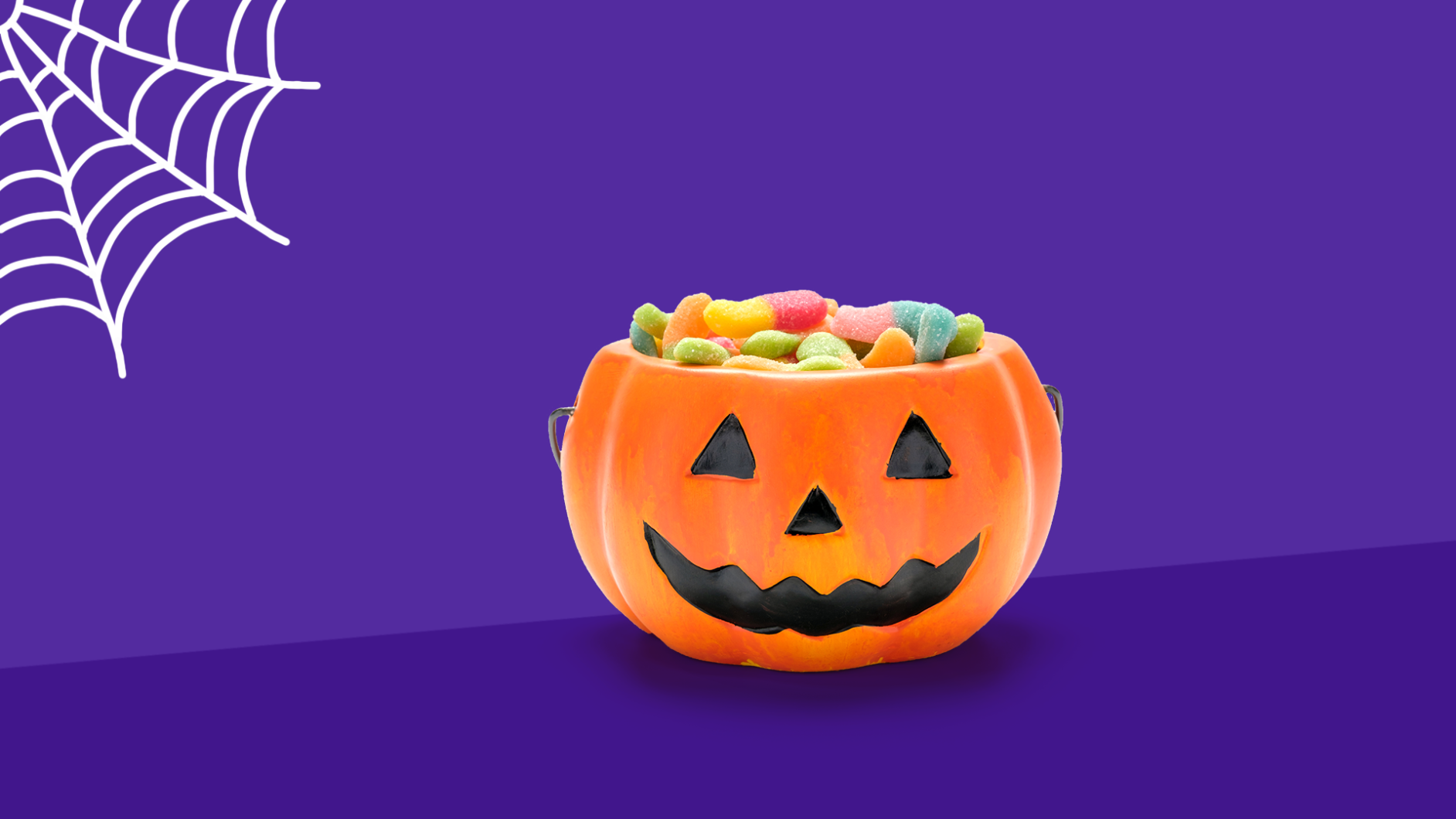Key takeaways
Eating a balanced meal before trick-or-treating and maintaining consistent carbohydrate intake are crucial for children with diabetes during Halloween.
Parents should supervise candy consumption, ensuring it fits within the child’s carbohydrate intake guidelines and possibly adjusting insulin doses accordingly.
Offering non-edible treats and creating a trade-in system for candy can provide a fun, inclusive Halloween experience without focusing on sugary sweets.
Hosting a Halloween party with low- or no-added sugar snacks and considering non-food treats keeps the spirit of Halloween alive while managing blood sugar levels.
Halloween can be a scary time—especially for parents of children with diabetes. Because along with all those trick-or-treating treasures (chocolates! lollipops! jelly beans!) comes the increased risk of dangerous blood sugar spikes. That doesn’t mean that children with diabetes have to miss out on all the spooky fun.
How to manage Halloween and children with diabetes
With careful planning and a little creativity, you and your child can enjoy all of the thrills (and none of the chills) of the spooky season. Here’s how:
1. Eat healthy ahead of time
While a healthy diet is an important part of any child’s diabetes maintenance program, dietitian LeeAnn Weintraub, MPH, RD, recommends being extra vigilant on All Hallows’ Eve.
“It is helpful to make sure that the meals on Halloween are balanced, which means they contain high-fiber carbs, vegetables, protein, and some healthy fat,” she says, adding: “Don’t go trick-or-treating on an empty stomach—have a well-balanced dinner before heading out.”
And while it may be tempting to limit sugar intake leading up to Halloween in order to mitigate the effects of all those sweet treats, it’s a bad idea, says Lainey Younkin, MS, RD, LDN, founder of Lainey Younkin Nutrition.
“Kids should not cut back on carbohydrates the day before in an effort to ‘save up,’” she says. “It’s important to keep carbohydrate intake consistent at meals and snacks and in line with how many carbs his or her doctor or dietitian has recommended.”
And one more thing: Be on the lookout for glucose levels actually dropping from all of that added activity.
“Kids who are not eating candy but doing a lot of extra playing and walking from trick-or-treating may be at risk for blood glucose getting too low,” says Weintraub. “A higher level of monitoring might be required to control levels.”
2. Devise a game plan for treats on Halloween night
Even the most level-headed, disciplined kid can get caught up in the holiday spirit, which is why you shouldn’t leave children to divvy up their trick-or-treating haul unsupervised.
“Children with diabetes can definitely enjoy their Halloween candy but need to count the number of carbohydrates in the candy and factor it into the amount their doctor has recommended they eat per meal,” says Younkin. “They may have to adjust their insulin so talk to the doctor ahead of time to ask how to properly adjust the dose.”
Weintraub recommends one fun method for candy consumption: “The portion of candy might be determined based on the age of the child and other factors. For example, maybe one piece per year of their age up to a certain limit,” she says. “[However], if blood sugar is running high it might make the most sense to delay eating Halloween candy for a later time.”
However you decide to dole out their prized stash, make sure to do it with a positive spirit. “You don’t want a child hiding sweets and eating them in secret, so parents should stay neutral—not making the candy seem bad and not making the child feel bad that they have diabetes and can’t enjoy candy like other children,” says Younkin.
3. Consider alternative treats
Non-edible Halloween treats
Despite what candy corporations would have you believe, there’s plenty of fun to be had on Halloween with little to no sugar involved, says Weintraub.
“I love the idea of non-edible Halloween treats like games, stickers, pencils, vampire teeth, etc., which can be incorporated to heighten the excitement while focusing less on candy and sweets,” she says.
You can also incentivize your child not to eat candy with this Halloween hack from Younkin. “Parents can create a ‘trade-in’ system where their child gives them some of their candy and in exchange, the child gets to pick out a toy or book,” she says. “This idea can be used whether a child has diabetes or not!”
The no-candy movement has actually been gaining momentum in recent years, with the Teal Pumpkin Project emerging as a result. The idea is simple: By placing a teal pumpkin on your doorstep, you signal to neighbors that you hand out non-food treats—such as small toys and trinkets—helping to make trick-or-treating a more inclusive experience for kids with food allergies and other dietary restrictions. It’s just one more fun way to celebrate Halloween without all the sweets!
RELATED: 5 tips for handling your child’s food allergy on Halloween
Diabetes safe Halloween treats
And not every edible treat has to be candy. If you’re hosting a Halloween party at your home, you can make all sorts of festive snacks that have low- or no-added sugar.
- Sugar-free jello jigglers cut into pumpkin or ghost shapes
- Vegetables and dip arranged as a skeleton
- Frozen peeled grapes (that double as eyeballs)
- Apples in an apple bobbing station
- Popcorn with plastic spiders crawling around the sides as decoration
- Roasted pumpkin seeds
- String cheese sticks with olives attached as eyes with cream cheese glue
- Guacamole spilling out of a hollowed out pumpkin
- Mini-hot dogs wrapped in puff pastry “bandages”
- Fresh fruit cut and arranged in a spooky design
Or, try swapping sugar for low-calorie sweeteners in your favorite recipes. With healthy—but delicious—options around, your child can enjoy snacks without risking a blood sugar spike.
Halloween candy carb counts for children with diabetes
So what’s the bottom line? Halloween candy can often fit into your child’s diet if it stays within their recommended carbohydrate intake. But, don’t be afraid to offer non-food treats instead to keep the spooky spirit alive—and your child healthy and happy.
If you’re doling out limited sweets, here are some of the treats that pack the biggest punch for the lowest number of carbs.

And if your child’s favorite candy didn’t make our list, read JDRF’s quick reference guide for more information.




